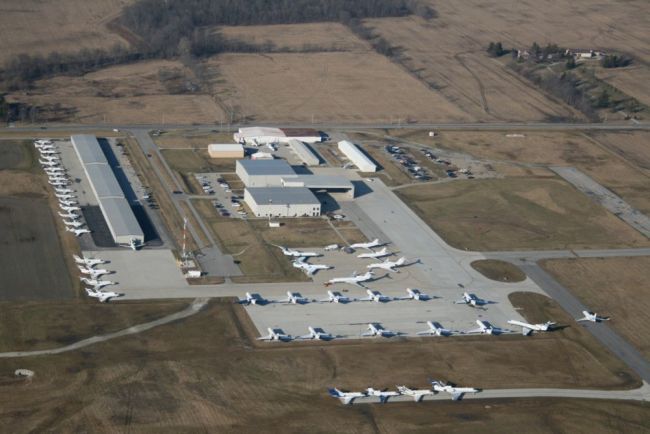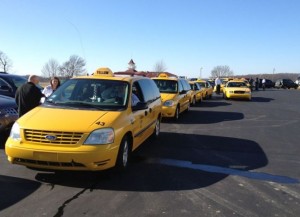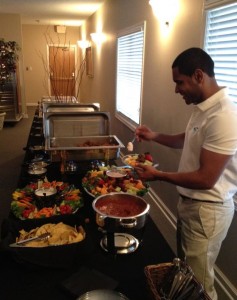Fansmanship Podcast Episode 217 – Chris Sylvester and Brint Wahlberg
It’s another podcast episode! Cal Poly basketball teams are at the Big...

A late Super Bowl Sunday afternoon aerial shot of the ramp at Indianapolis Executive Airport. Parking was full but planes were allowed to drop passengers and then depart and wait out the game at an airport further away. Photo by: Ray Rice, Montgomery Aviation
Super Bowl flights make aviation history
It is close to 10 p.m. on Sunday in Indianapolis and a last desperate “Hail Mary” from Tom Brady bounces harmlessly out the back of the end zone. As the Giants, and my friend (a New Jersey native) erupt with joy, the viewing party at this transformed hangar at the Indianapolis International Airport immediately begins buzzing with activity. You see, the game has been a brief halftime, minus Madonna, for over an estimated 1200 flight crews, plus an army support staff at nearly a dozen airports in the Indianapolis region. Now, the hundreds of airport employees, air traffic controllers, government officials, and volunteers who labored for several days to land what is unofficially a Super Bowl record for visiting aircraft, must now prepare for the mass exodus that began as a trickle halfway through the game and would become a torrent by the next morning.
When my friend and I arrived in his Piper Arrow the day before from Wisconsin, we didn’t know that Super Bowl weekend would also become what several area airport representatives said was “the greatest event in Indiana aviation history.” By the time we had crisscrossed the Indy metro area visiting four other airports earlier in the day, we learned that this was no embellishment.
Super Sunday began very early for one flight crew we met at Greenwood Executive Airport in Greenwood, which is a little more than 10 miles southeast of Indy Int’l. They departed empty at 4 a.m. from southern Florida and flew to Morristown, New Jersey to pick up passengers and then fly to Indianapolis. With their load of football fans on their way downtown, the crew headed to a hotel for their FAA-mandated 10 hours of rest. They would be back later in the evening to prepare for a 1 a.m. departure.
Similar scenarios were playing out across the country as the sun rose on a crisp and clear Sunday in Indy. This also made air traffic management more efficient since controllers can shrink the separation distances in visual conditions. Indy Int’l has the only control tower within 30 miles and so several other nearby airports opted to accept temporary towers to increase the pace of traffic at their airports which usually are what is known as “uncontrolled”. I won’t go into what that means in aviation parlance only to say an uncontrolled field on any other day is normal and safe.
While all the airports in the region were demonstrating “Hoosier Hospitality”, Greenwood is quite a contrast to the FBO at Indy Int’l. The airport has one North-South runway and a small terminal building that caters to mostly light piston and jet aircraft with typically eight seats or less. This is determined by aircraft weight and runway length not the size of the plane. Many larger planes could land here, but might not get out.
Waiting for each arrival at Greenwood was quite literally the entire city. The planes were met by aircraft marshallers made up of volunteers from the local chapter of the Experimental Aircraft Association. Arrivals were also brought homemade food and bean-bag chairs to turn a conference room into a proper viewing area. As the passengers walked into the building, the newly-elected Mayor of Greenwood, Mark W. Myers, was there to offer a welcoming handshake while the President of the Airport Board, David A. Kovach held the door open. Myers was eager to have this day go well; the airport has had a renaissance recently and a Super Bowl-weekend of fuel and services revenue could solve many of the airport’s revenue issues.
Greenwood was our first stop on our whirlwind airport tour and it was our first and only celebrity sighting until we were just about to leave the next day. Today it was Green Bay Packer Linebacker A.J. Hawk and a gentleman later identified as UFC Fighter Dan Henderson. Both of the notables were gracious, with Hawk taking time to talk to a young Giants fan that had arrived about the same time in another plane.
The next stop on our FBO tour was Eagle Creek Airpark, just north of Indy Int’l. Unlike Greenwood, Eagle Creek featured a temporary tower. The pace was a little slower, with a few light jets and more turboprops and piston aircraft. Inside the FBO, the staff was friendly and professional and the familiar game-day style buffet was being prepared. An enterprising Girl Scout had set up a table of cookie boxes near the food; it would not be the only Girl Scout cookie stand we would see that day.
While the pace on the ramp at Eagle Creek was steady at two in the afternoon, it was slow enough that a local pilot in a trainer had time to practice landings, to the amusement of the air traffic controllers. These controllers are from all over the country and had bid against their peers to win the opportunity to work during the Super Bowl. For anyone who is interested, the Super Bowl of air traffic control is not here but in Oshkosh, Wisconsin at an event called AirVenture, which becomes the busiest airport in the world for seven days.
There were many reasons aircraft didn’t fly-in the day before the game. Whatever the reason, the only option left was to find an airport on Sunday where they could “drop and go.” But time on the clock was running out. If you wanted to land at an airport within 10 miles of Lucas Oil Stadium, you had to be on the ground by 4:30 p.m. when what is known as a Temporary Flight Restriction (TFR) went into effect. TFRs are a product of 9/11 and there is still a debate within the aviation community about their necessity, especially for sporting events.

TAXI! Cabs await passengers at Eagle Creek Air Park, which is west of downtown Indianapolis. Photo By FlyOverFan
There was a rumor about town that the President was going to come, which normally necessitates a TFR. While the President did not make an appearance, at least one prominent political figure did attend. According to our high-level source (our on-ramp van driver at Indy Int’l) it was Secretary of State Hillary Clinton. We saw the Gulfstream painted in U.S. Government livery, but didn’t bother to confirm it since we were under the impression she was a Yankee fan… .
We headed further north, outside of the “10-mile zone” to Indianapolis Executive airport, where Montgomery Aviation is based. This family-owned FBO has two other locations in Indiana, but this is ground zero due to the fact that they can still take arrivals after 4:30. As we drove up to the airport we saw dozens of aircraft tails lined up on every paved surface. This was the most impressive collection of aircraft we had seen.
When we arrived around 3:30 p.m., Montgomery Vice President Andrea Montgomery said that all 95 of her parking slots were already spoken for and that there were many “orphaned” aircraft that were circling above due to a traffic jam that started out east. This caused aircraft bound for airports inside the TFR zone to miss their arrival slot and were looking for a place to drop their passengers.

The buffet for pilots at the Palomino Ballroom. Montgomery Aviation rented the space to give pilots a quite place to watch the game. Photo By FlyOverFan
Montgomery employees were working as fast as they could to receive aircraft for “drop and gos” which provided an opportunity for them to showcase their new taxi-thru awning that is like a really big car port. For the flight crews that were allowed to stay, Montgomery cleverly rented a ballroom one-half mile away which provided a quiet respite to watch the game, far away from the din of the perpetual motion of aircraft and people.
It’s now time for kickoff, and air traffic in the area has mostly ceased, especially near the city center. The TFR is not scheduled to be lifted until 12 a.m. so most flight crews and fans are finding either a stadium seat or one that is comfy and near a TV. Being at the Super Bowl is not always about the game as we heard from some flight crews that they were scheduled to leave with passengers during the third quarter who did have tickets to the game.
The Patriots could not replicate the “Hail Mary” prowess that the Giants demonstrated three weeks earlier against the Packers and now halftime for the aviators is over. Across the Indy metro area, pilots begin waking up their planes while hoping their passengers are the first to return so that they can be near the front of the departure line. A crew in from Canada tells us that air traffic control is lifting the TFR early and just an hour after the game ends, the parade of aircraft — most headed to Boston and New York — will begin. It’s a parade that will last all night, but not reach a crescendo until around 10 a.m. Monday morning.
Monday morning means it is time for us to go home too. Favorable weather will make our route more direct and entirely over land. But first we need to get out of Indy Int’l and, after we started our engine, it took another hour and thirteen minutes before we are cleared for takeoff. The layout of the runways at Indy is like a table. The two parallel runways that run to the southwest are the legs and the table top which has a large overhang on each end, is where all the planes are parked.
The two main FBOs are located on each end of this table and all the aircraft are parked all over. With everyone leaving at different times from different areas of the table it takes a long time to get all the aircraft lined up and moving to the center of the table and down to the legs where they can be cleared for takeoff. (see airport diagram)
By contrast, in 2006 I flew a King Air (turboprop) to and from the Final Four Championship game in St. Louis. This was a worthy, high-profile event, but the arrival and departure traffic jams lasted hours rather than sustained over several days as was witnessed here in Indy this weekend.
The amount of heavy metal that visited the Indy metro area this past weekend was impressive. One FBO official estimated that he had “billions of dollars” worth of aircraft on his ramp alone. Multiply that by all the airports in the area and the aerial Super Bowl embodied the official marketing term used by the Host Committee, “The Epicenter of Awesome”.
It’s another podcast episode! Cal Poly basketball teams are at the Big...
One of my favorite authors, Jeff Pearlman joins this edition of the...
Donovan Fields is one of the most joyous basketball players I’ve ever...
With the tournament more than underway and the sweet sixteen fast approaching,...
(Article by Luke “Loco” Johnson. Forgive website faux pas.) The genius of...
* Team Records accurate as of Friday morning, 8:39 A.M. The hyped hoopla...
